外刊经贸知识选读全部课文翻译
- 格式:doc
- 大小:183.00 KB
- 文档页数:28
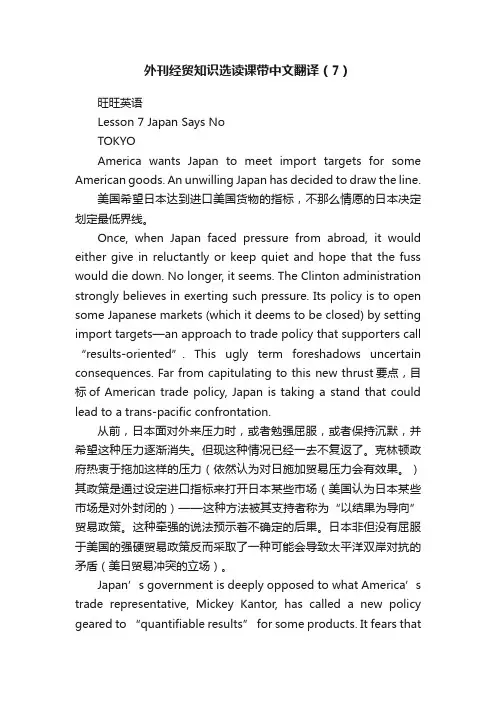
外刊经贸知识选读课带中文翻译(7)旺旺英语Lesson 7 Japan Says NoTOKYOAmerica wants Japan to meet import targets for some American goods. An unwilling Japan has decided to draw the line.美国希望日本达到进口美国货物的指标,不那么情愿的日本决定划定最低界线。
Once, when Japan faced pressure from abroad, it would either give in reluctantly or keep quiet and hope that the fuss would die down. No longer, it seems. The Clinton administration strongly believes in exerting such pressure. Its policy is to open some Japanese markets (which it deems to be closed) by setting import targets—an approach to trade policy that supporters call “results-oriented”. This ugly term foreshadows uncertain consequences. Far from capitulating to this new thrust要点,目标of American trade policy, Japan is taking a stand that could lead to a trans-pacific confrontation.从前,日本面对外来压力时,或者勉强屈服,或者保持沉默,并希望这种压力逐渐消失。
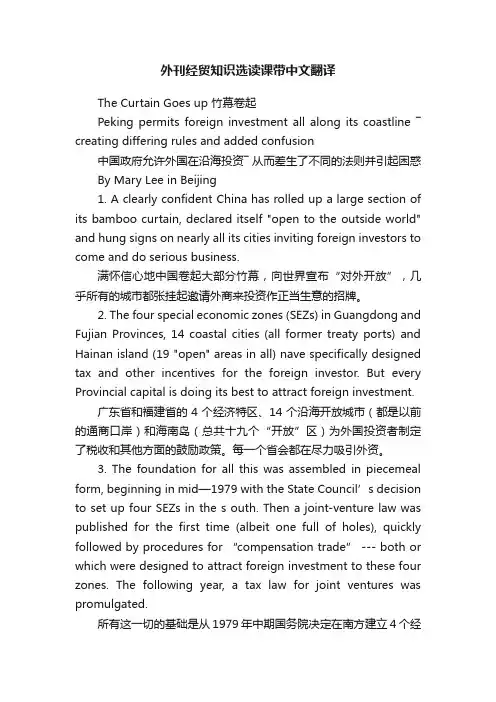
外刊经贸知识选读课带中文翻译The Curtain Goes up 竹幕卷起Peking permits foreign investment all along its coastline ― creating differing rules and added confusion中国政府允许外国在沿海投资― 从而差生了不同的法则并引起困惑By Mary Lee in Beijing1. A clearly confident China has rolled up a large section of its bamboo curtain, declared itself "open to the outside world" and hung signs on nearly all its cities inviting foreign investors to come and do serious business.满怀信心地中国卷起大部分竹幕,向世界宣布“对外开放”,几乎所有的城市都张挂起邀请外商来投资作正当生意的招牌。
2. The four special economic zones (SEZs) in Guangdong and Fujian Provinces, 14 coastal cities (all former treaty ports) and Hainan island (19 "open" areas in all) nave specifically designed tax and other incentives for the foreign investor. But every Provincial capital is doing its best to attract foreign investment.广东省和福建省的4个经济特区、14个沿海开放城市(都是以前的通商口岸)和海南岛(总共十九个“开放”区)为外国投资者制定了税收和其他方面的鼓励政策。

旺旺英语Lesson 15Weekly Commodities (telex) 每周商品行情Commodities 1商品行情(-)econews by Kate Kavanagh Oil prices seesaw to three-month low in “big bang week London”, Oct. 31 (afp)—the attention of commodities dealers was last week captured initially by events on the stock exchange, where Monday’s big bang was muffled by computer failures, but turned later to the troubled oil market.(法新社)10月31日电:在“伦敦大爆炸改革周”中,石油价格起伏不定,跌至三个月来的最低点。
——上周商品交易者们的注意力先是被股票交易所发生的事情吸引,那里的计算机出了故障从而抑制了周一的“大爆炸改革”;但随后,交易者们的注意力又转向了混乱的石油市场。
The unexpected departure of sheik ahmed zaki yamani from his post as Saudi Arabian oil minister aggravated existing uncertainty concerning the future direction of oil prices in view of severe world oversupply.在国际市场严重供大于求的情况下,沙特阿拉伯石油部长亚马尼的突然离职使本来就起伏不定的油价变得更加难以预料。
Unstable crude prices in turn prompted falls in platinum and gold, the latter to its lowest since early September, aggravated by the withdrawal of investment support as the dollar regained ground.动荡的原油价格反过来又加速了白金和黄金的降价,而且由于美元重收失地,投资者纷纷撤回投资,黄金还降到了九月初以来的最低点。
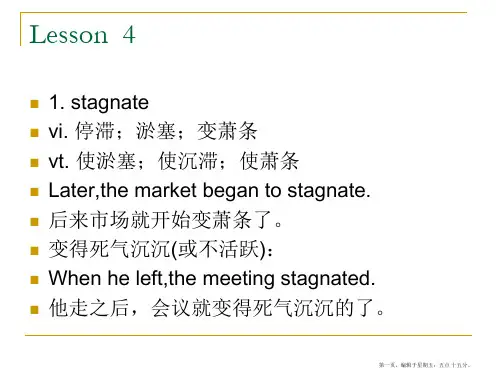
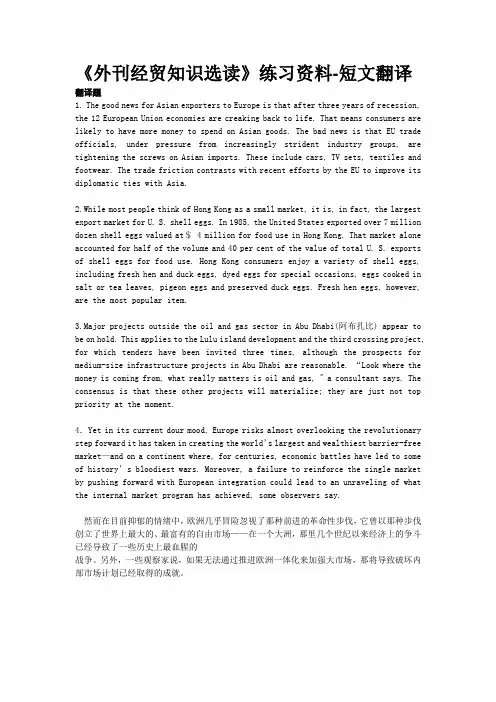
《外刊经贸知识选读》练习资料-短文翻译翻译题1. The good news for Asian exporters to Europe is that after three years of recession, the 12 European Union economies are creaking back to life. That means consumers are likely to have more money to spend on Asian goods. The bad news is that EU trade officials, under pressure from increasingly strident industry groups, are tightening the screws on Asian imports. These include cars, TV sets, textiles and footwear. The trade friction contrasts with recent efforts by the EU to improve its diplomatic ties with Asia.2.While most people think of Hong Kong as a small market, it is, in fact, the largest export market for U. S. shell eggs. In 1985, the United States exported over 7 million dozen shell eggs valued at$ 4 million for food use in Hong Kong. That market alone accounted for half of the volume and 40 per cent of the value of total U. S. exports of shell eggs for food use. Hong Kong consumers enjoy a variety of shell eggs, including fresh hen and duck eggs, dyed eggs for special occasions, eggs cooked in salt or tea leaves, pigeon eggs and preserved duck eggs. Fresh hen eggs, however, are the most popular item.3.Major projects outside the oil and gas sector in Abu Dhabi(阿布扎比) appear to be on hold. This applies to the Lulu island development and the third crossing project, for which tenders have been invited three times, although the prospects for medium-size infrastructure projects in Abu Dhabi are reasonable. “Look where the money is coming from, what really matters is oil and gas, " a consultant says. The consensus is that these other projects will materialize; they are just not top priority at the moment.4.Yet in its current dour mood, Europe risks almost overlooking the revolutionary step forward it has taken in creating the world’s largest and wealthiest barrier-free market—and on a continent where, for centuries, economic battles have led to some of hist ory’s bloodiest wars. Moreover, a failure to reinforce the single market by pushing forward with European integration could lead to an unraveling of what the internal market program has achieved, some observers say.然而在目前抑郁的情绪中,欧洲几乎冒险忽视了那种前进的革命性步伐,它曾以那种步伐创立了世界上最大的、最富有的自由市场——在一个大洲,那里几个世纪以来经济上的争斗已经导致了一些历史上最血腥的战争。
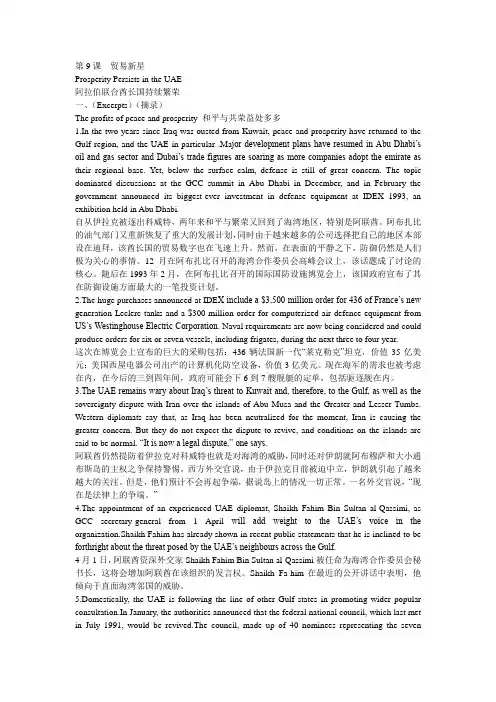
第9课贸易新星Prosperity Persists in the UAE阿拉伯联合酋长国持续繁荣一、(Excerpts)(摘录)The profits of peace and prosperity 和平与共荣益处多多1.In the two years since Iraq was ousted from Kuwait, peace and prosperity have returned to the Gulf region, and the UAE in particular .Ma jor development plans have resumed in Abu Dhabi’s oil and gas sector and Dubai’s trade figures are soaring as more companies adopt the emirate as their regional base. Yet, below the surface calm, defense is still of great concern. The topic dominated discussions at the GCC summit in Abu Dhabi in December, and in February the government announced its biggest-ever investment in defense equipment at IDEX 1993, an exhibition held in Abu Dhabi.自从伊拉克被逐出科威特,两年来和平与繁荣又回到了海湾地区,特别是阿联酋。
阿布扎比的油气部门又重新恢复了重大的发展计划,同时由于越来越多的公司选择把自己的地区本部设在迪拜,该酋长国的贸易数字也在飞速上升。
然而,在表面的平静之下,防御仍然是人们极为关心的事情。
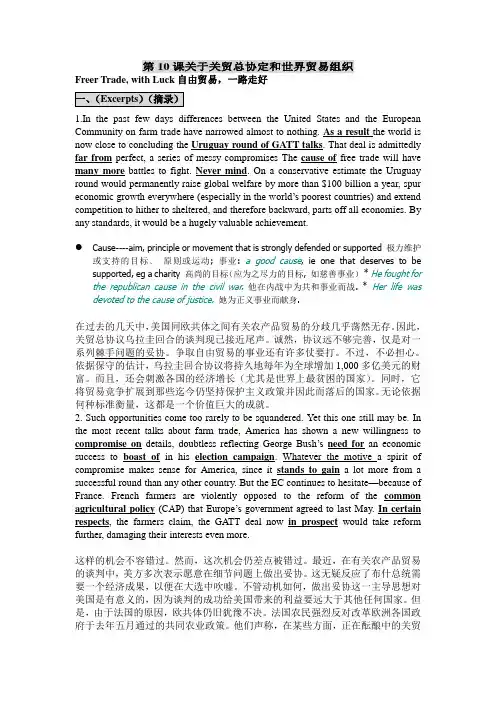
第10课关于关贸总协定和世界贸易组织Freer Trade, with Luck自由贸易,一路走好1.In the past few days differences between the United States and the European Community on farm trade have narrowed almost to nothing. As a result the world is now close to concluding the Uruguay round of GATT talks. That deal is admittedly far from perfect, a series of messy compromises The cause of free trade will have many more battles to fight. Never mind. On a conservative estimate the Uruguay round would permanently raise global welfare by more than $100 billion a year, spur economic growth everywhere (especially in the world’s poorest countries) and extend competition to hither to sheltered, and therefore backward, parts off all economies. By any standards, it would be a hugely valuable achievement.Cause----aim, principle or movement that is strongly defended or supported 极力维护或支持的目标﹑原则或运动; 事业: a good cause, ie one that deserves to be supported, eg a charity 高尚的目标(应为之尽力的目标, 如慈善事业)* He fought for the republican cause in the civil war. 他在内战中为共和事业而战. * Her life was devoted to the cause of justice. 她为正义事业而献身.在过去的几天中,美国同欧共体之间有关农产品贸易的分歧几乎荡然无存。
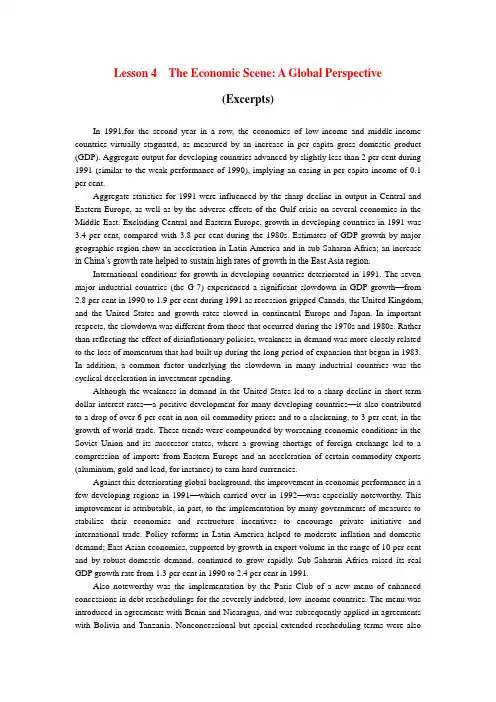
Lesson 4 The Economic Scene: A Global Perspective(Excerpts)In 1991,for the second year in a row, the economies of low-income and middle-income countries virtually stagnated, as measured by an increase in per capita gross domestic product (GDP). Aggregate output for developing countries advanced by slightly less than 2 per cent during 1991 (similar to the weak performance of 1990), implying an easing in per capita income of 0.1 per cent.Aggregate statistics for 1991 were influenced by the sharp decline in output in Central and Eastern Europe, as well as by the adverse effects of the Gulf crisis on several economies in the Middle East. Excluding Central and Eastern Europe, growth in developing countries in 1991 was 3.4 per cent, compared with 3.8 per cent during the 1980s. Estimates of GDP growth by major geographic region show an acceleration in Latin America and in sub-Saharan Africa; an increase in China’s growth rate helped to sustain high rates of growth in the East Asia region.International conditions for growth in developing countries deteriorated in 1991. The seven major industrial countries (the G-7) experienced a significant slowdown in GDP growth—from 2.8 per cent in 1990 to 1.9 per cent during 1991 as recession gripped Canada, the United Kingdom, and the United States and growth rates slowed in continental Europe and Japan. In important respects, the slowdown was different from those that occurred during the 1970s and 1980s. Rather than reflecting the effect of disinflationary policies, weakness in demand was more closely related to the loss of momentum that had built up during the long period of expansion that began in 1983. In addition, a common factor underlying the slowdown in many industrial countries was the cyclical deceleration in investment spending.Although the weakness in demand in the United States led to a sharp decline in short-term dollar interest rates—a positive development for many developing countries—it also contributed to a drop of over 6 per cent in non-oil commodity prices and to a slackening, to 3 per cent, in the growth of world trade. These trends were compounded by worsening economic conditions in the Soviet Union and its successor states, where a growing shortage of foreign exchange led to a compression of imports from Eastern Europe and an acceleration of certain commodity exports (aluminum, gold and lead, for instance) to earn hard currencies.Against this deteriorating global background, the improvement in economic performance in a few developing regions in 1991—which carried over in 1992—was especially noteworthy. This improvement is attributable, in part, to the implementation by many governments of measures to stabilize their economies and restructure incentives to encourage private initiative and international trade. Policy reforms in Latin America helped to moderate inflation and domestic demand; East Asian economics, supported by growth in export volume in the range of 10 per cent and by robust domestic demand, continued to grow rapidly. Sub-Saharan Africa raised its real GDP growth rate from 1.3 per cent in 1990 to 2.4 per cent in 1991.Also noteworthy was the implementation by the Paris Club of a new menu of enhanced concessions in debt reschedulings for the severely indebted, low-income countries. The menu was introduced in agreements with Benin and Nicaragua, and was subsequently applied in agreements with Bolivia and Tanzania. Nonconcessional but special extended rescheduling terms were alsoaccorded to ten severely indebted middle-income countries.In the commodity market, prices of all major categories declined in 1991. The index of non-oil primary commodity prices in nominal dollar terms decline for the third consecutive year, and the index in real terms hit an all-time low. Growth in the volume of world trade in constant dollar terms declined from 5 per cent in 1990 to 3 per cent in 1991, mainly the result of the slowdown in industrial countries’ import demand. There were no breakthroughs in the Uruguay Round of GATT negotiations on key elements, and the outcome remains in doubt.In matters relating to the environment, the United Nations Conference on Environment and Development, held in June 1992 in Rio de Janeiro, produced an “Earth Charter,” or declaration of basic principles for the conduct of nations and peoples with respect to environment and development; agreements on specific legal measures, including conventions on climate change and biodiversity, and principles for a framework agreement on forests; and an agenda for action (“Agenda 21”), establishing the environmental work program agreed by the international community for the period beyond 1992 and into the twenty-first century.Major Industrial CountriesGrowth in the G-7 countries decelerated from 2.8 per cent in 1990 to 1.9 per cent in 1991 (see Table 1). The broad trend was the outcome of largely unexpected setbacks to recovery in the United States and the United Kingdom and the apparent onset of a slower period of economic growth in Japan and Germany. A cyclical slowdown of investment was apparently a major component of the slowdown: Investment decelerated or fell during 1991 in all the G-7 countries. In Japan, the cyclical slowing of investment was probably the dominant factor in weaker growth, but a slump in construction of rental housing and the fading of a tax-cut-induced boom in auto sales also contributed. In Germany, the role of investment was dominant, as well. Unification further boosted investment, which then appeared to diminish, as expectations of profitability were dampened by higher wages and high short-term nominal and real interest rates. Upward pressures on wages and interest rates generally dampened economic activity in Germany during 1991. The special factor there was the pressure on interest rates that a rose from the financing of unification and from anti-inflationary monetary policy. Inflation as measured by the GDP deflator slackened in most of the G-7 countries. It continued to decelerate in North America and edged down in Japan. The record in Europe was mixed, however, inflation eased somewhat in Italy and in the smaller economies such as Spain and Portugal, but accelerated by about one half of a percentage point in the United Kingdom (the result of statistical anomalies) and by more than a point in Germany.The slowdown of the industrial countries in 1991 partly originated in structural problems inherited from the 1980s. Slower growth in Europe in 1991 revealed that unemployment, for instance, was still a structurally problematic area. The unemployment rate in the four largest European economies was 7.8 per cent in 1990, near the peak of the business cycle, and rose to 8.3 per cent in 1991. Financial stress brought on by excessive debt in the household and corporate sectors was an example of another kind of structural problem, in particular for the economies of Japan and the United States. Financial institutions in these two countries adopted more conservative lending policies, curtailing financing of higher-risk projects such as commercial construction and highly leveraged corporate transactions. A number of weaker institutions were also consolidated through bankruptcy, merger and reorganization. These developments played some part in the general tightening of credit during 1991, which may have helped to slow the paceof investment in the United States and Japan. Weak growth of credit and a fall in some asset prices probably slowed consumption, as well.A notable development in 1991 was a narrowing of current-account imbalances of most major industrial countries (see Table 2): The U.S. current-account deficit moved to near balance (only 0.2 per cent of gross domestic product). The trade component of the deficit narrowed as lower inflation and earlier dollar depreciation improved competitiveness, while the transfers component moved into substantial surplus because of war-related payments. Moreover, there was a remarkable swing in the German current account—from a surplus equivalent to 3.2 per cent of GDP in 1990 to a deficit of 1.3 per cent. A continuation of the surge of imports that followed unification, as well as the earlier appreciation of the deutsche mark, contributed to the swing. The Japanese surplus on current account rose from 1.2 per cent of gross domestic product in 1990 to 2.1 per cent in 1991.Several important developments in monetary conditions also took place in 1991. Reflecting more accommodative monetary policy, nominal short-term interest rates fell in the United States and Japan (see Figure 1). In contrast, the increase in German nominal short-term interest rates to postwar highs narrowed the potential of some European Monetary System partners to reduce their rates. The German short-term real interest rate also rose relative to real interest rates in the United States and Japan (see Figure 2). The slope of the Japanese yield curve became less negative and the United States’ curve more positive as short-term interest rates fell more quickly than long-term rates in countries declined by 2 per cent.The influence of the Gulf crisis, including the spike in oil prices and dislocations in the Middle East, was widespread; the effects of the crisis on Iraq and Yugoslavia(these two countries alone account for some 4 per cent of developing countries’aggregate GDP) resulted in steep declines in output.Structural transformation and the collapse of trade with the Soviet Union and its successor states combined to induce a deep recession in most of Central and EasternEurope, while the sharp compression of imports by the Soviet Union adverselyaffected its other trading partners (such as India).Weakness of policy implementation affected economic performance in a number of countries.Aggregate statistics for 1991 were dominated by the sharp decline in output in Central and Eastern Europe and by the severely adverse effects of the Gulf crisis on the economies of Middle Eastern countries. Estimates of GDP by major geographic region reveal that growth of output accelerated in Latin America and in sub-Saharan Africa, while a pick-up in China helped sustain Asian activity. Despite a sharp slowdown in India, where GDP growth fell from 5.5 per cent in 1990 to 2.5 per cent, the population-weighted growth rate of developing countries’ GDP—3.5 per cent in 1991—continued to exceed the ordinary measure.Despite the slowdown in the industrial countries—particularly in the United States—improvements in economic performance in Latin America were widespread. The region’s GDP rose by 3.0 per cent in 1991, thus reversing the slide in annual per capita income that had taken place over the past decade. Growth rates were in excess of 4 per cent in Argentina, Chile, and Mexico and reached a high of 9.1 per cent in V enezuela. Policy reforms covering fiscal adjustment, trade and investment liberalization, the financial sector, and public-enterprise restructuring and privatization, supported by debt restructuring, have helped to moderate inflationin the region and strengthen domestic demand. Chile has now been growing at an average annual rate of 4.5 percentage points for the past six years, and since 1989 Mexico has been enjoying a broad-based expansion at rates of 3 per cent to 4 per cent a year. Recent major policy steps undertaken in Argentina have brought a recovery in confidence and growth, and a reflow of capital to a number of countries in the form of foreign direct investment and portfolio investment suggests an increased level of market confidence in the progress achieved to date.Growth in output in East Asia, supported by continued vibrant performance of the region’s exports, as well as by a firming of domestic demand, particularly in China, accelerated to about 6.8 per cent in 1991. The sharp acceleration of GDP growth in China, from 4.5 per cent to over 6 per cent, was supported by improvements in industrial output, higher levels of consumer spending, and significant gains in the export of manufactures. Despite the slowdown in industrial-country markets, export volumes for the group of East Asian countries advanced at double-digit rates, implying gains in market share. A moderate slackening in GDP growth from the rapid 9 per cent-to-10 per cent gains of 1990 occurred in the dynamic economies of the Republic of Korea, Malaysia, and Thailand, in part reflecting a catch-up of imports. The major risk facing this highly trade-oriented region is the potential for sluggishness or disruption in world-trade flows. Economic weakness in some of the region’s traditional export markets has underlined the importance of market diversification, including a further strengthening of ties within the region. Increasingly buoyant intra-regional trade in East Asia may be viewed as evidence of an ongoing process of “market-oriented” regional integration, a development that could partially offset lackluster progress in the area of multilateral trade agreements.The GDP growth rate in 1991 of the South Asia region was 2.8 per cent, down from 5.6 per cent in 1990. The decline was partly caused by India’s reining in of its budget deficit and the short-term effects of the implementation of strong emergency stabilization measures, which, coupled with the collapse of the Soviet market and recession in the U.S., contributed to a sharp slowdown in industrial activity and exports. The emergency measures included a severe compression of imports, tight credit policies and exchange-rate devaluation.Output in the Middle East and North Africa region grew weakly at 0.8 per cent in 1991, reflecting the shocks from the Gulf crisis. Petroleum-price declines reduced revenues in oil-exporting countries, and many countries in the region were adversely affected by declines in workers’ remittances and tourism revenues, as well as by the need to increase social spending in support of workers repatriated from Iraq and the Gulf countries.In Europe and Central Asia, GDP contracted by about 7 per cent, as stabilization and reform programs in several countries had not yet led to a bottoming-out in their economies. Average output of the Central and East European economies, including Y ugoslavia, is estimated to have dropped by 14 per cent, following a decline of 8.7 per cent in 1990. Estimates of economic decline among the five reforming economies in this region range from 7.5 per cent in Hungary to 26 per cent in Bulgaria. However, efforts to liberalize imports and diversify exports—which followed the disbanding of the Council for Mutual Economic Assistance (CMEA) trading block—led to strong growth in trade between Eastern Europe and the industrialized countries.Growth accelerated in sub-Saharan Africa to 2.4 per cent in 1991, in part the result of the indire ct stimulation of Nigeria’s economy by the Gulf crisis, not only through temporarily higher oil prices but also through its success in exploiting new oilfields quickly. For the past five years, the prices of nonoil commodities exported by most West African countries (robusta coffee andcocoa, for example) have fared worse than those that are particularly important for East and Southern Africa countries (mild arabica coffee and copper, for example). Such sustained losses in terms of trade have contributed to growth performance in West Africa that is poorer than in East and Southern Africa.--From The World Bank Annual Report, 1992 in a row / / 连续as / Az, Ez/ conj.以...方式;像...一样stagnate / s5tAgneit/ v.(经济等)不发展;停滞aggregate / 5Agrigeit/ a.合计的easing / / n.(限制等)放松;缓和;(价格)下降趋势;(利率)降低per capita income / / 人均收入acceleration / AkselE5reiFEn/ n.加快;增速sustain / sEs5tein/ n.保持;使持续不断high rates of growth / / 高增长率deteriorate / di5tiEriEreit/ v.恶化;变坏;(质量或价格的)下降underlying / 5QndE5laiiN/ v.根本的;基本的cyclical / -kl/ a.循环的;周期的slacken / 5slAkEn/ v.变缓慢;减弱compound / 5kRmpaund, kEm5paund/ v.加重compression / kRm5preFEn/ v.压缩moderate / 5mRdErit/ n.使缓和;减轻;减弱robust / rEu5bQst/ v.强健的;强有力的domestic demand / / 国内需求concession / kEn5seFEn/ a.让步debt rescheduling / / 重新安排债务的偿还计划breakthrough / 5breikWru:/ n.突破性的进展onset / 5Rnset/ n.开始slump / slQmp/ n.暴跌rental housing / / 出租房屋fading / / n.逐渐消失;渐弱;衰退tax-cut-induced boom / / 由减税引发的繁荣diminish / di5miniF/ v.减少;降低;缩减dampen / 5dAmpEn/ v.使扫兴;减少;降低anomaly / E5nRmEli/ n.反常之事物;异例excessive / ik5sesiv/ a.过多的;过分的;极度的curtail / kE:5teil/ v.消减leverage / 5lZvEridV/ v.(使)举债经营consolidate / kEn5sRlideit/ v.把...联合为一体;统一;合并merger / mE:dVE/ n.兼并accommodative / E5kRmEdeitiv/ a.肯通融的comparable (to) / / a.可比较的;相似的register / 5redVistE/ v.达到;取得;获得pick-up / / n.好转;恢复;进步reverse / ri5vE:s/ v.使好转protfolio investment / / 证劵投资vibrant / 5vaibrEnt/ a.充满生气的dynamic / dai5nAmik/ a.有活力的catch-up / / n.竞争sluggishness / / n.萧条disruption / dis5rQpFEn/ n.混乱diversification / daivE:sifi5keiFEn/ n.多样化intra-regional / / 地区内的buoyant / 5bRiEnt/ a.活跃的;有生气的integration / inti5greiFEn/ n.结合,合并;统一,整体lackluster / / a.无生气的;灰暗的rein in / / 抑制couple with / / 并提;把...联系起来,加之...workers' remittance / / 工人侨汇(在国外工作的工人汇回本国的外汇收入)repatriate / ri:5pAtrieit/ v.把...遣返回国contract / 5kRntrAkt, kEn5trAkt/ v.收缩;减少bottoming-out / / (经济衰退局面等)降至最低点后即将复苏robusta / / n.粗壮咖啡豆arabica / E5rAbikE/ n.咖啡籽1.In 1991, for the second year in a row, the economies of low-income and middle-income countries virtually stagnated, as measured by an increase in per capita gross domestic product (GDP).2.Aggregate output for developing countries advanced by slightly less than 2 per cent during 1991(similar to the weak performance of 1990), implying an easing in per capita income of 0.1 per cent.3.Excluding Central and Eastern Europe, growth in developing countries in 1991 was 3.4 per cent, compared with 3.8 per cent during the 1980s.4.…. an increase in China’s growth rate helped to sustain high rates of growth in the East Asia region.5.International conditions for growth in developing countries deteriorated in 1991.6.The seven major industrial countries(the G-7) experienced a significant slowdown in GDP growth …7.…it also contributed to a drop of over 6 per cent in nonoil commodity prices …8.These trends were compounded by worsening economic conditions in the Soviet Union and its successor states, …9.Policy reforms in Latin America helped to moderate infla tion and domestic demand …10.robust domestic demand11.the third consecutive year12.There were no breakthroughs in the Uruguay Round of GATT negotiations on key elements,…13.Growth in the G-7 countries d ecelerated…14.The broad trend was the outcome of largely unexpected setbacks to recovery in the United States and the United Kingdom and the apparent onset of a slower period of economic growth in Japan and Germany.15. a slump in construction of rental housing16.… expectations of profitability were dampened by higher wages and high short term nominal and real interest rates.17.Inflation as measured by the GDP deflator slackened in most of the G-7 countries.18.It continued to decelerate in North America and edged down in Japan.19.curtailing financing of higher-risk projects20.These devolopments played some part in the general tightening of credit during 1991 …21. a narrowing of current-account imbalances22.dollar depreciation23.the earlier appreciation of the deutsche mark,24.The slope of the Japanese yield curve25.primary commodities and manufactures26.merchandise exports27.the spike in oil prices28.the sharp compression of imports29.the severely adverse effects of the Gulf crisis on the economies of Middle Eastern countries30. a pick-up in China31.significant gains in the export of manufactures32. a double-digit rates33.market diversification34.reining in of its budget deficit35.exchange-rate devaluation36. a bottoming-out。
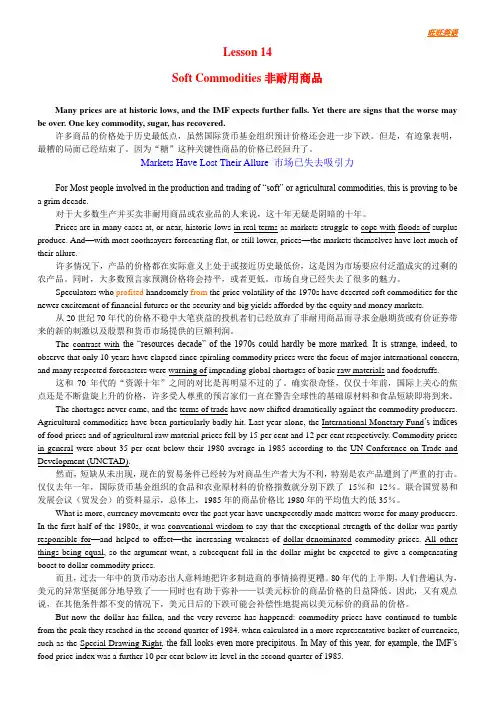
旺旺英语Lesson 14Soft Commodities非耐用商品Many prices are at historic lows, and the IMF expects further falls. Yet there are signs that the worse may be over. One key commodity, sugar, has recovered.许多商品的价格处于历史最低点,虽然国际货币基金组织预计价格还会进一步下跌。
但是,有迹象表明,最糟的局面已经结束了。
因为“糖”这种关键性商品的价格已经回升了。
Markets Have Lost Their Allure 市场已失去吸引力For Most people involved in the production and trading of “soft” or agricultural commodities, this is proving to be a grim decade.对于大多数生产并买卖非耐用商品或农业品的人来说,这十年无疑是阴暗的十年。
Prices are in many cases at, or near, historic lows in real terms as markets struggle to cope with floods of surplus produce. And—with most soothsayers forecasting flat, or still lower, prices—the markets themselves have lost much of their allure.许多情况下,产品的价格都在实际意义上处于或接近历史最低价,这是因为市场要应付泛滥成灾的过剩的农产品。
同时,大多数预言家预测价格将会持平,或者更低。
市场自身已经失去了很多的魅力。
Speculators who profited handsomely from the price volatility of the 1970s have deserted soft commodities for the newer excitement of financial futures or the security and big yields afforded by the equity and money markets.从20世纪70年代的价格不稳中大笔获益的投机者们已经放弃了非耐用商品而寻求金融期货或有价证券带来的新的刺激以及股票和货币市场提供的巨额利润。

Lesson 4 The Economic Scene: A Global Perspective经济景观:全球视野(Excerpts)1. In 1991,for the second year in a row, the economies of low-income and middle-income countries virtually stagnated, as measured by an increase in per capita gross domestic product (GDP). Aggregate output for developing countries advanced by slightly less than 2 per cent during 1991 (similar to the weak performance of 1990), implying an easing in per capita income of 0.1 per cent.1991年,中低收入国家以人均国内生产总值(GDP)测算的经济增长连续两年处于停滞状态。
1991年(与1990年的不景气状况相似),发展中国家的总产量的增长率略低于2%,这意味着其人均收入降低了0.1%。
2. Aggregate statistics for 1991 were influenced by the sharp decline in output in Central and Eastern Europe, as well as by the adverse effects of the Gulf crisis on several economies in the Middle East. Excluding Central and Eastern Europe, growth in developing countries in 1991 was3.4 per cent, compared with 3.8 per cent during the 1980s. Estimates of GDP growth by major geographic region show an acceleration in Latin America and in sub-Saharan Africa; an increase in China’s growth rate helped to sustain high rates of growth in the East Asia region.1991年的总数据,不仅受到了海湾危机对中东几个国家的经济的有害作用的影响,而且也受到了中、东欧国家的产量的急剧下降的影响。
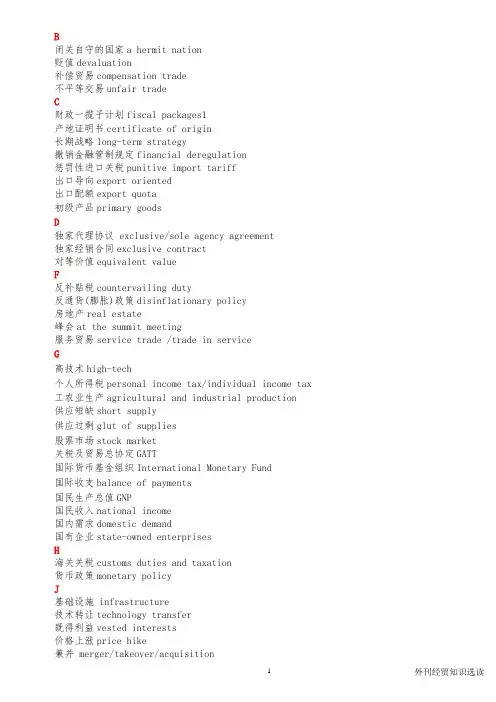
B闭关自守的国家a hermit nation贬值devaluation补偿贸易compensation trade不平等交易unfair tradeC财政一揽子计划fiscal packages1产地证明书certificate of origin长期战略long-term strategy撤销金融管制规定financial deregulation惩罚性进口关税punitive import tariff出口导向export oriented出口配额export quota初级产品primary goodsD独家代理协议 exclusive/sole agency agreement独家经销合同exclusive contract对等价值equivalent valueF反补贴税countervailing duty反通货(膨胀)政策disinflationary policy房地产real estate峰会at the summit meeting服务贸易service trade /trade in serviceG高技术high-tech个人所得税personal income tax/individual income tax 工农业生产agricultural and industrial production 供应短缺short supply供应过剩glut of supplies股票市场stock market关税及贸易总协定GATT国际货币基金组织International Monetary Fund国际收支balance of payments国民生产总值GNP国民收入national income国内需求domestic demand国有企业state-owned enterprisesH海关关税customs duties and taxation货币政策monetary policyJ基础设施 infrastructure技术转让technology transfer既得利益vested interests价格上涨price hike兼并 merger/takeover/acquisition金融危机financial crisis进口税customs duties经常项目current account经济衰退economic recession经济特区the Special Economic Zone经济作物cash crops竞争优势competitive advantages据保守估计on a conservative estimate据粗略估计at a rough estimateK可兑换货币convertible currencyL利润汇款profit-remittance利息付款debt service/interest payment良好的基础设施good infrastructure流动资产liquid assetsM贸易壁垒trade barriers贸易差额trade balance贸易歧视trade discrimination贸易顺差trade surplus贸易谈判trade negotiation贸易展销会trade fairs and exhibitions贸易制裁trade sanctionsO欧洲大陆European continent欧洲一体化European integrationQ期货市场futures market强阻力good resistance清算协议clearing agreementR人均国内生产总值per capita/head GDP(gross domestic products)人均收入 per capita income/income per capitaS商品市场commodities/goods market商务代表trade representative商业周期business cycle生产力productive forces世界贸易组织World Trade Organization世界银行the World Bank市场份额market share市场力量market forces试销test marketing试销市场test market收盘价closing level双边贸易bilateral trade双边条约bilateral pacts双重税carbon taxT通货紧缩deflationW外汇储备foreign exchange reserves外汇收入foreign exchange earnings外商独资sole foreign funded无壁垒市场barrier-free market无形贸易invisible tradeX现货市场physical market萧条depression新兴工业fledgling industriesY易货贸易barter trade易于变卖的资产liquid assets银行兼并merger of banks硬通货hard currency优惠关税preferential tax rate有形贸易收支/项目visible trade account预算赤字budget deficitZ证券投资portfolio investment政府采购.government procurement知识产权intellectual property right制成品 manufactured goods/finished goods智囊团 / 顾问班子brain trust中国出口商品交易会Chinese Export Commodities Fair 主权争端sovereignty dispute资本货物capital goods资本密集型投资capital-intensive investment资本转移capital transfer自给自足self-sufficient自由/无壁垒市场barrier-free market自由市场free market最惠国待遇most-favored nation status。
旺旺英语Lesson 5 U.S. Is Prepared to See Trade Relations Worsen美国已做好准备任凭其贸易关系恶化By Peter BehrWashington Post Service 1. WASHINGTON—The Clinton administration is drawing the first lines of a tougher U.S. policy on trade, signaling to Europe and Japan that it will demand fairer treatment for American exports and is prepared to see relationships with U.S. trading partners get worse before they get better.克林顿政府正计划推行强硬的贸易政策路线,由此向欧洲和日本发出信号要求其更为公正的对待美国的出口,同时也表示美国政府已做好准备对待贸易关系恶化而非改善的状况。
2. The strongest signal came last week, when Mickey Kantor, the U.S. trade representative, moved quickly to cite the 12-nation European Community for “intolerable” discrimination against U.S. companies seeking government contracts within the Community. The administration will begin retaliating in six weeks if EC policies remain unchanged, Mr. Kantor said.美国贸易代表Mickey Kantor在上周发出了最为强烈的信号,他对欧共体12国限制美国公司参与欧洲政府采购计划迅速做出反应,认为这种做法是“不可忍受”的,并且警告说如果欧洲在六周之内不改变其现有做法那么美国将会采取报复性措施。
旺旺英语Lesson 12Soft Drink Wars: the Next Battle 软饮料战:下一次战争The reformulation of Coke has given the feuding cola giants a chance to go at each other again.可口可乐的重新配方为长期不和的可乐巨头提供了一个新开战的机会。
But Coca-Cola and PepsiCo are spoiling for yet another fight, and this time they’re picking on the little guys: non-cola makers like Seven-Up and Dr Pepper.By Monci Jo Williams 但是可口可乐和百事可乐一心想进行另一场战斗,这一次它们选中了小企业:“七喜”和“佩拍博士”。
In the U.S. soft drink industry, where 1% of the market is worth $ 300 million in retail sales, Coca-Cola and PepsiCo don’t wage mere market share battles. They fight holy wars. These days the fighting is on two fronts. One is on the vast plains of the cola business, where the reformulation of Coke has Pepsi on the defensive. The other is in the back alleys of the smaller, non-cola market. Until now these have been dominated by other companies. As growth of high-calorie colas slows, however, Coca-Cola and PepsiCo are invading new territory.在美国的软饮料行业,1%的市场份额就意味着3亿美元的零售额,可口可乐公司和百事可乐公司进行的不仅仅是争夺市场份额的斗争,他们进行的是“圣战”。
旺旺英语Lesson 8Here Comes Korea, Inc.Like Japan in the 1960s, the old “Hermit Kingdom” is poised for将迎来an assault 冲击on the world’s markets像20世纪60年代的日本一样,一个古老的“闭关自守的国家”已准备好向世界市场发起冲击。
The ritual begins shortly after dawn. As the early morning light filters through the windows of Lucky-$8 billion conglomerate, issues instructions that echo around the world. In Huntsville, Ala., 200of things to come. As one of Koo’s lieutenants puts it: “Our future lies in becoming a truly global company.”黎明后,仪式开始。
当晨光透过汉城乐喜金星公司高耸的总部大厦的窗户时,这家拥有80亿美元资本的跨行业公司董事长具滋暻向全世界发布了引起反响的指示。
在阿拉巴马州的亨茨维尔,200名产业工人每年生产100万台“金星”彩电。
在加利福尼亚的硅谷,身着白色工装的研究人员在探索目前最先进的半导体技术的秘密。
在沙特阿拉伯的著拜尔,该公司正在进行一个新的宠大石油化学企业的最后试验。
这充分显示了其全球的势力范围,也是即发生的许多事情的预兆。
正如具滋暻的一名下属所言:“我们的未来就是成为一个真正的全球性公司。
”For South Korea as a whole, that seems as much a prophecy as an ambition. Like Japan in the 1960s, the country is poised for an assault on the world’s export markets. Its surging $81 billion economy is churning out a flood of increasingly sophisticated products, from shoes, toys and telephones to video recorders and microprocessors. Korea’s mighty conglomerates dominate Middle East construction, and they command key shares of the world’s shipbuilding, textile and steel industries. Their affiliates, joint ventures and subsidiaries girdle the globe, stretching from Australia, Indonesia and India to Norway, Spain and Gabon, Hyundai and Daewoo, with annual sales of $10 billion and $6 billion respectively, are pushing into the U.S. auto market, riveting the attention of American and Japanese manufacturers. Another colossus, the $9 billion Samsung, has started marketing a “super-tech” 256K computer chip—encouraging some Koreans to speak confidently of the day when they will become the world’s second largest manufacturer of basic electronic components, outstripping America and running just behind Japan.对整个韩国来说,那似乎不仅是个预言,也是个理想;像20世纪60年代的日本一样,这个国家准备向世界出口市场发起攻击。
Lesson 4 The Economic Scene: A Global Perspective经济景观:全球视野(Excerpts)1.In 1991,for the second year in a row, the economies of low-income and middle-income countries virtually stagnated, as measured by an increase in per capita gross domestic product (GDP). Aggregate output for developing countries advanced by slightly less than 2 per cent during 1991 (similar to the weak performance of 1990), implying aneasing in per capita income of 0.1 per cent.1991 年,中低收入国家以人均国内生产总值(GDP)测算的经济增长连续两年处于停滞状态。
1991 年(与1990 年的不景气状况相似),发展中国家的总产量的增长率略低于2%,这意味着其人均收入降低了0.1% 。
2.Aggregate statistics for 1991 were influenced by the sharp decline in output in Central and Eastern Europe, as well as by the adverse effects of the Gulf crisis on several economies in the Middle East. Excluding Central and Eastern Europe, growth in developing countries in 1991 was3.4 per cent, compared with 3.8 per cent during the 1980s. Estimates of GDP growth by major geographic region show an acceleration in Latin America and in sub-Saharan Africa; an increase in China ’s growth rate helped to sustain high rates of growth in the East Asia region.1991 年的总数据,不仅受到了海湾危机对中东几个国家的经济的有害作用的影响,而且也受到了中、东欧国家的产量的急剧下降的影响。
Lesson 1 China in the Market Place市场经济中的中国(Excerpts)(摘录)Barry Coulthurst examines the development of China’s trade policy and the present state of the overseas links--巴里库尔塞斯特对中国贸易政策的演变和当前与海外经济往来状况的研究自从中华人民共和国成立以来,中国对外贸易的模式发生了巨大的变化。
20世纪50年代,中国向苏联和东欧国家出口农产品换取制造品和资本设备,用于侧重于重工业发展所必须的工业化项目。
1958~1959年的“大跃进”最初在工农业生产上带来收益,但随后又导致了严重的经济平衡。
三年自然灾害(1959-1961)加剧了经济问题,造成1960-1962年间的国民收入和对外贸易额的减少。
20世纪60年代,苏联经济和技术援助撤走,导致了中国与苏联及经互会成员国的贸易转向于日本和西欧国家的贸易。
中国对外贸易政策的一贯宗旨是重视与第三世界国家发展贸易关系。
“文化大革命”期间(1966-1976)工农业生产一落千丈,交通运输限制更加严重,中国对外贸易的增长再次中断。
The Sino-USA agreement on trade relations, which came into force(解释:施行)in February 1980, accords China most-favoured nation treatment.(最惠国待遇)在实现四个现代化中起着很大作用的对外贸易在近几年发展很快。
1978年2月于日本签订了一个主要贸易协定,根据这个协定,中国向日本出口每盒石油换取工业设备和技术。
1978年中国也与欧共体签订了长期贸易协定,继1979年初与美国的外交关系正常化以后,中美贸易发展迅速。
美国遵照1980年1月25日生效的中美贸易关系协定给与中国最惠国待遇。
Breakdown分类A commodity breakdown of China’s trade shows that fuels (燃料)accounted for 24 per cent of total exports in 1982, 中国的贸易商品分类表明,1982年燃料占总出口的24%,食品占13%,纺织纤维和矿砂占7%,制造品占55%(最重要的产品是纺织品、化工产品、机械及运输设备)。
自从新中国建立以来,中国一直重视进口资本设备已使加强工业部门。
但是1982年进口的主要是食品,占进口总额的22%,轻工业产品占20%,机械和运输设备占17%。
During the past few years a major objective of the Chinese authorities(权威、权力)has been to reduce(减少)the proportion(比例)of agricultural exports, while increasing that of industrial and mineral products. A wide variety(多样性)of industrial goods are now exported and Chinese capital equipment has been used by a number of developing countries to establish projects in areas such as agriculture, forestry, light industry, food processing, water conservation and transport and communications.过去几年,中国当局的主要贸易目标一直是减少农产品出口的比例,增加工业和矿产品的出口比例。
中国现在出口种类繁多的工业品,许多发展中国家采用中国的资本设备,用于农业、林业、轻工业、食品加工业、水保护、交通和通信领域中的建设项目The Balance Shifts 收支平衡变化The US dollar value of Chinese exports increased at an average rate of almost 18 per cent per annum between 1978 and 1983, while imports increased by approximately (大约)11 per cent per annum. As a result, the visible trade surplus (有形贸易顺差)rose sharply from US $ 1.4 billion in 1981 to US $ 4.4 billion in 1982 and US $ 3.7 billion in 1983. Exports grew much faster than imports during this period not only because of the strong emphasis placed on exporting by China’s economic planners, but also because a number of industrial projects were postponed in 1979. Official(官方)recognition(承认)that foreign technology could play a major role in modernising the Chinese economy had caused imports to rise by more than 50 per cent in 1978 placing undue strain on the national economy. Grain imports have fallen sharply over the past few years ---- China became a net grain exporter in 1984 ---- and in 1983 the country started to export soyabeans and cotton.1978-1983年建,中国出口额按美元计算,平均每年增长率近18%,每年进口额增长率约是11%。
因此有形贸易顺差从1981年的14亿美元猛增到1982年的44亿美元,1983年是37美元。
同期的出口比进口增长快得多,这不仅是因为中国的经济决策者十分重视出口,还因为许多工业项目推迟到了1979年。
官方认识到,在中国经济走向现代化的过程中外国技术起着主要作用,这种认识导致1978年进口增长50%以上,给国民经济造成了不应有的重负。
在过去几年粮食进口急剧减少—1984年中国成为粮食净出口国---1983年中国开始出口大豆和棉花。
1984年外贸发展模式出现反向发展,出口值增长10%,进口值急剧上升到38%,结果有形贸易支出出现逆差,达11亿美元。
去年进口的大幅度上升归因于政府的贸易政策和对外贸易政策的成功以及区域升温的经济活动。
Direction of Trade 贸易方向香港是中国的主要出口市场,1983年约占总出口的26%(尽管许多出口商品从那里再出口到其他地方)。
其他重要的出口市场报考日本,1983年占20%;还有美国,占总出口近8%。
过去几年欧共体展中国出口额大约11-12%(欧共体内主要的出口市场是德国和英国),出口到经互会国家的比例从1978年的约15%下降到6%。
1983年非石油国家(不包括香港)占中国出口总额的23%。
In sharp contrast(鲜明对比)1983年发展中国家给中国提供的进口不到15%,与发达国家形成鲜明对比。
工业国家中对中国来说最大的供应国是日本,占26%;其次是美国,占13%。
1983年欧共体国家占15%,经互会国家占8.2%。
The successful outcome to negotiations(谈判)between Britain and China about the future(未来)of Hong Kong will strengthen(加强)Sino-British relations and is expected to boost(推动)trade between the two countries. A large British economic and trade delegation(代表团), headed by Lord Young, Minister without Portfolio(不管大臣), visited China in March. The value of Chinese exports to Britain, which rose rapidly between 1977 and 1980, declined in 1981-1982, but recovered strongly in 1983; imports from the United Kingdom followed a similar pattern(相似的样式). The most important Chinese exports to Britain in 1983 were clothing, textile fibres(纺织品纤维), tea and food products while the leading British exports included iron and steel(铁和钢), machinery and transport equipment, scientific instruments, chemicals and textile fibres.中英关于香港未来谈判的成功将会加强中英关系并有望促进两国贸易。
有不管大臣杨勋爵率领的一个大型英国经济和贸易代表团3月份访问了中国。
中国出口到英国的总值在1977-1980期间迅速增长。
1981-1982年间下滑,但1983年恢复很快;从英国的进口基本上也是一样。
1983年中国出口到英国的最重要的物品是服装、纺织纤维、茶叶和食品;英国的主要出口商品包括钢铁、机械及运输设备、科学仪器、化工产品和纺织纤维。
Chinese officials stress(着重)the importance of introducing advanced technology to domestic industry(国内的工业), but the need is for technology of varying(不同的)degrees of sophistication, not necessarily for advanced technology as that term is understood in the West.中国政府重视向国内的工业引进先进的的技术,但是需要的是各种各样的高精尖技术,,而不一定是西方人所理解的先进技术。